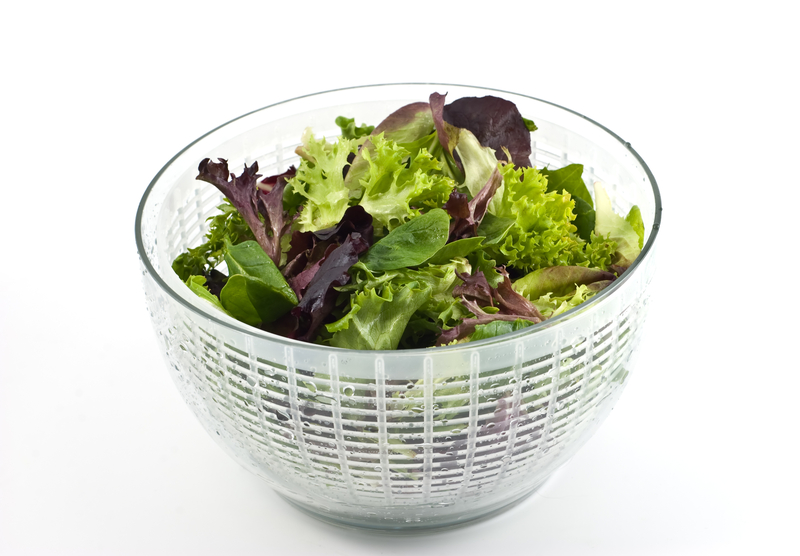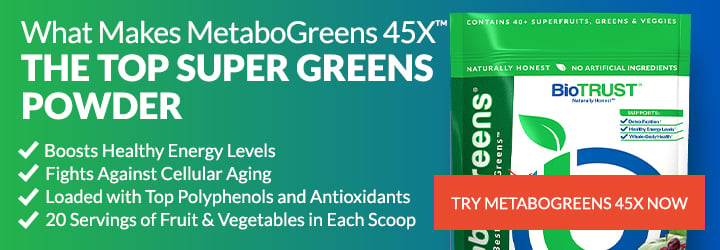The Best Salad Greens For Your Big Salad (kale lovers beware)

When it’s a hot day, is there anything better for lunch than a BIG salad? “What’s in the BIG salad?” “Big lettuce, big carrots, tomatoes like volleyballs…” Well, at least at Jerry, George, and Elaine’s favorite diner. Of course, the base of any good BIG salad is a pile of leafy green vegetables, yet there are so many to choose from. If you create your own BIG salad, what are the best salad greens to pick for your base?
It should come as no surprise that some greens pack more nutritional punch than others. And what you choose as your base could be the difference between getting the nutrition you need and, well, not.
Fortunately, the U.S. Centers for Disease Control and Prevention (CDC) has come up with a list of “powerhouse fruits and vegetables” to help navigate which foods are the most nutrient-dense. The foods on this list are “most strongly associated with reduced chronic disease risk,” such as cancer and heart disease, by providing 10% or more, on average, of the daily value for 17 important nutrients, including potassium, fibers, protein, calcium, iron, thiamin, riboflavin, niacin, folate, zinc, and vitamins A, B6, B12, C, D, E, and K. 1
Greens at the top of the CDC’s green leafy vegetable list include chard, beet greens, spinach, chicory, and leaf lettuce. However, it’s worth noting that phytochemical data wasn’t included, so not all of the health benefits are reflected in the scores. In fact, even though phytochemicals like polyphenols are technically considered non-nutrients, they are biologically active compounds that may play a powerful role in health promotion and the prevention and treatment of lifestyle diseases. That’s not joke. Thus, other foods likely deserve to be included when all of the compounds within the food are considered.
Getting your dose of daily greens, especially those in the cruciferous family like kale and arugula, has also been found to fight several types of cancer due to the glucosinolates (one of those “non-nutrient” phytochemicals mentioned above) they provide. 2 Salad greens like lettuce, kale, collard greens, and spinach have also been linked to a delay in cognitive decline. 3 And finally, leafy greens are a key component of a heart-healthy diet. 4
Taste, of course, is just as important. If your salad is too bitter for your taste, you won’t eat it. Or, you’ll try to drown it in salad dressing, which could end up burying the nutrition as well. So, it’s important to consider the best salad greens not just by what ranks highest in terms of nutrient density, but what also ranks highest on your list of foods you enjoy.
That said, let’s head out to the garden to take a look at the best greens for your BIG salad!
14 Best Salad Greens For Your Big Salad
1) Butter lettuce. Also known as Boston, Bibb, or buttercrunch lettuce, butter lettuce can add not just a richer flavor and texture, it’s also highly nutritious, rich in folate, iron, and potassium, and it comes in at just 7 calories per cup.
2) Leaf lettuce. With a mere five calories per cup, loads of potassium and vitamins A and K, leaf lettuce also has a mild flavor that goes well on just about any salad.
3) Romaine. Often one of the biggest components of Mediterranean salads, romaine is another powerhouse food that provides plenty of vitamin A (81% in a cup) and other B vitamins at just 8 calories.
4) Red-leaf lettuce. Add some color along with a good amount of vitamin A to your salad with red-leaf lettuce at just 5 calories per cup.
5) Spinach. Fresh or wilted, spinach is often a staple of salads, especially when paired with sweet fruit or beets and perhaps some goat cheese. It also provides all-around good nutrition, including potassium and other vitamins and minerals. If you’re eating spinach for the iron, however, it’s best to cook it. A cup only counts for 7 calories.
6) Beet greens. If you’re buying beets, save the green parts for your salad! They’re another colorful, nutrient-dense option that provides tons of nutrition, including vitamins A and K with a mere 8 calories per cup.
7) Watercress. You don’t see these little round leaves in salads as often as you could, which is a shame as they are one of the best salad greens. They’re so rich in nutrients, like vitamins A, C, and K, with a mere 4 calories per cup.
8) Endive. Want to take your salad up a level as far as “class”? Add some endive (a kind of chicory) for flavor, plus a good dose of vitamins A and K, at just 8 calories per cup.
9) Radicchio. While it’s not a leafy green (as it’s red in color), this vegetable, another kind of chicory, provides over 100% of your daily value of vitamin K and adds an amazing burst of color and flavor to any big salad at only 9 calories per cup. Other types of chicory greens to look for to add to your salad include frisée and escarole.
10) Chard. A top powerhouse food, chard is high in nutrients, including nearly 300% of your daily value of vitamin K per cup. With just 7 calories per cup, you’ll also get a healthy amount of magnesium, and with its red or rainbow stem, it’s sure to make your whole meal more eye-catching. In case you haven’t tried it, chard is in the beet family, tastes a bit like spinach, and is very versatile.
11) Arugula or rocket. With a distinct spicy or peppery flavor (especially in the mature leaves), many people think this green is at the top of the list, but it doesn’t have as many nutrients as found in many of the other greens on this list. Yet, it is very low calorie (6 per cup) and can add a unique flavor to your big salad, so go ahead and toss in a handful of these best salad greens. If you want a milder flavor, grab some baby arugula instead of the more mature greens.
12) Dandelion greens. While many people consider the dandelion a weed, it was actually brought to North America by the European settlers as both a food and medicine in the 1600s, and it is now found just about anywhere—from fields to forests, lawns to gardens. It especially seems to enjoy growing in disturbed areas, such as after a fire or avalanche. Choose some young, fresh, bright green leaves (with minimal blemishes) to add a pleasant bitterness to your salad, similar in taste to types of chicory greens. These salad greens are also an excellent source of vitamins A, C, E, and K, as well as a smaller amount of B vitamins. They also provide several minerals like iron, calcium, magnesium, and potassium with 25 calories per cup.
13) Kale. While kale is all the rage as a nearly perfect food in some circles, not everyone loves it in a salad. It is high in vitamins A, C, and K along with calcium and is an excellent food for any diet—whether you add it to your salad or not is up to you. While still a low-calorie food, it does top the calorie chart for leafy greens with 33 per cup, but it also provides 3.5 grams of protein. To make kale more appealing and tender as a salad green, it can be sautéed with some onion and garlic or just chopped into smaller pieces and allowed to sit in and absorb some salad dressing a bit longer than other greens. And don’t forget to remove the tough ribbing before you start chopping.
14) Iceberg. With its pale color, minimal flavor, and lack of nutrients (at least compared to many other best salad greens), iceberg lettuce is sometimes shunned from everyday salads. It’s also the lettuce many of us grew up with as it’s been around since the 1940s and is known for traveling well. Yet, iceberg lettuce provides just 10 calories per cup, it’s rich in fiber, and it has a high water content. In fact, it’s around 95% water. It may not be the best of the bunch, but it doesn’t deserve to be banned from your veggie list either, especially if it’s the only one your kids or grandkids are willing to eat. It goes great as the base of a chopped or wedge salad—well-known American traditions in many regions. If iceberg is on your list, it’s best to combine it with some of the other more nutrient-dense salad greens above. That said, if you love it, you don’t need to stop eating it just because it ranks near the bottom of the list.
Other Great Salad Greens Options
There’s a wide variety of salad greens that you can find at your local farmer’s market or grocery store, and you can even grow many of them in your own garden. Others to consider adding to any salad mix include:
- Coral lettuce (a variety of loose-leaf lettuce), which has a mild flavor and frilly curls on the leaves
- Little gem lettuce, which has crisp, sweet, sturdy leaves
- Mache (aka, field salad, lamb’s lettuce, or corn salad), which has tender, delicate leaves and a mild, slightly sweet flavor
- Chinese cabbage (aka Napa or celery cabbage)
- Mesclun, often found in spring mixes, which adds a delightful pinkish purple color to brighten any salad
- Oakleaf lettuce, which is a type of butter lettuce that’s shaped a bit like oak tree leaves, with a delicate mild flavor that goes well with other greens
- Stem lettuce (aka celery lettuce, asparagus lettuce, Chinese lettuce)
- Mizuna (aka Japanese greens, spider mustard, California peppergrass), which provides a stronger, spicier flavor that complements many other greens
- Sweet potato leaves, which can be harvested without impacting the tubers. These tend to taste similar to kale, only sweeter and earthier
How to Build a Perfect Salad with the Best Salad Greens
Once you’ve chosen your mix of leafy greens, it’s time to build the perfect salad. (You can also purchase salad green mixes that provide a range of the greens listed above.)
- Start with three cups of your favorite greens.
- Add one to two cups of other vegetables, like carrots, cucumbers, zucchini, cabbage, avocado, etc., sliced or chopped into bite-sized pieces.
- For a full, filling meal that will keep you energized all afternoon, add a ½ cup of cooked whole grains like rice, quinoa, or barley, and then top with 3 to 4 ounces of protein like cooked chicken, fish, or beans.
- Then top with two to three tablespoons of a healthy dressing or just a mix of oil and vinegar.
- Top with some seeds or nuts—if you want some extra crunch—some herbs like parsley, cilantro, or basil for an extra punch of flavor, and enjoy!
This one salad can knock off nearly all of your daily vegetable requirements in a single fantastic meal. Take that, George! The BIG salad really is worth it, no matter who gets the credit.
And if a big salad isn’t your thing (or, you’ve just had your fill and are feeling burnt out), you can still enjoy the best salad greens by tossing them into an omelet, smoothie, or soup. You can also sauté many of them with a little olive oil, garlic, and a splash of lemon juice. Or, use them as a “wrap” for your taco or sandwich instead of a tortilla, bread, etc.







